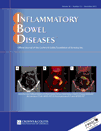Association of perinuclear antineutrophil cytoplasmic antibodies and anti–Saccharomyces cerevisiae antibodies with vienna classification subtypes of Crohn's disease
Abstract
Background The Vienna classification of Crohn's disease (CD) subdivides patients according to their age at diagnosis (A), disease location (L), and disease behavior (B). Aim The aim of this study was to test whether perinuclear antineutrophil cytoplasmic antibodies (pANCAs) or anti–Saccharomyces cerevisiae antibodies (ASCAs) correlate to subtypes of CD according to this classification. Methods pANCA, ASCA–immunoglobulin (Ig) A, and ASCA-IgG were detected by indirect immunofluorescence in 120 sera of patients with CD and compared with their Vienna classification. Results Patients with diagnosis of CD at an age of 40 years or older (A2) were more frequently pANCA-positive than those whose disease started at a younger age (A1) (19% vs. 5%, p < 0.05). pANCA-positive patients almost exclusively belonged to the nonpenetrating disease groups (B1 and B2); only one patient had penetrating disease (B3) (B3 vs. non-B3: p = 0.02). There was a cluster of pANCA-positive patients within the A1 B2 L3 subgroup (B2: stricturing disease; L3: ileocolonic involvement). Only 7.5% of ASCA-IgA–positive patients presented with CD that was limited to the colon (L2). ASCA-IgA and ASCA-IgG were more frequently found in patients with upper gastrointestinal disease (L4) (ASCA-IgA: 66.7% vs. 31.5% in non-L4, p < 0.05; ASCA-IgG: 44.4% vs. 27.9%, p < 0.05). Conclusion pANCA and ASCA may be useful in predicting subtypes of CD. They therefore may be helpful in developing subtype-specific disease management strategies.




